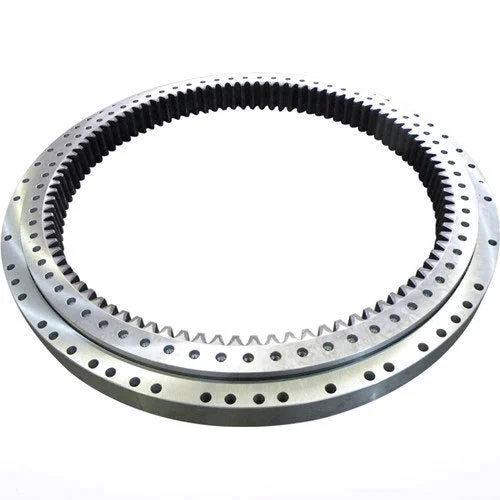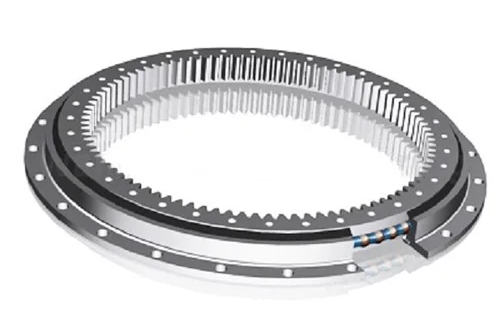How do you assemble a cross roller bearing?
- Definition of crossed roller bearings
Crossed roller bearing is a special high-performance rolling bearing. Its characteristic is that the two rows of rollers inside the bearing are arranged at a 90-degree cross, which makes the bearing have higher rigidity and stability when bearing radial load and axial load. This kind of bearing has high dynamic load bearing capacity, low friction coefficient, and excellent rotation accuracy. It is widely used in various high-precision, high-load, and high-speed mechanical systems.
- Application scenarios of crossed roller bearings
(1) CNC machine tools: CNC machine tools have extremely high requirements for rotation accuracy and dynamic performance. Crossed roller bearings can provide stable and precise support for the machine tool spindle, improving the machine tool’s processing accuracy and production efficiency.
(2) Industrial robots: Industrial robots require high-precision and high-rigidity rotating joints. Crossed roller bearings can provide excellent rotation performance and load capacity and are important components of robot joints.
(3)Aerospace: In the aerospace field, crossed roller bearings are widely used in key parts such as main shafts and servos of various aircraft due to their high precision, high speed and high load capacity.
(4)Precision instruments: Precision instruments have extremely high requirements for rotation accuracy and dynamic performance. Crossed roller bearings can provide stable and accurate support for the instrument and improve the measurement accuracy and stability of the instrument.
- Working principle of crossed roller bearings
The working principle of crossed roller bearings is different from ordinary rolling bearings. In ordinary rolling bearings, the rollers move linearly along the inner ring of the bearing, while in crossed roller bearings, due to the cross arrangement of the rollers, the rollers can produce bidirectional displacements in the axial and radial directions when bearing loads. Has better rigidity and stability. In addition, the rotation accuracy of crossed roller bearings has also been significantly improved, because the cross arrangement of the rollers causes the friction between the inner and outer rings to cancel each other out, reducing the friction loss and heating of the bearing.

- Installation method of crossed roller bearings
(1) Preparation work
Before starting to install crossed roller bearings, the following preparations need to be made:
1.Prepare the required tools and materials: crossed roller bearings, nuts, flat washers, lock washers, lubricants, cleaning agents, plastic or rubber hammers, measuring tools, etc.
2.Check the crossed roller bearings: Confirm that the bearings are not damaged, rusted, worn, etc., and check whether the mating surface is smooth.
3.Clean the case: Use cleaning fluid to clean the inside of the case to remove impurities and residues.
4.Prepare the installation surface: Apply lubricant inside the casing to reduce friction and improve installation efficiency.
2) Installation steps
1.Clean crossed roller bearings carefully
Due to the special structure of crossed roller bearings, their inner and outer surfaces need to be carefully cleaned before installation. Wipe the bearings with detergent and a clean cloth to ensure the surface is free of residue and dust. Pay special attention to keeping the mating surface clean to prevent impurities from affecting the installation effect.
2.Assemble the bearing so that the rings and rolling elements rotate
Assemble the rings and rolling elements of the crossed roller bearing to ensure free rotation. Pay attention to keeping the gap between the inner and outer rings of the bearing and the rolling elements even to avoid sticking. During assembly, no tools or knocks should be used to avoid damaging the bearings.
3.Apply a certain amount of pressure so that the bearing can be firmly installed on the casing
Install the crossed roller bearing on the casing through nuts and flat washers. Start by placing the flat pad inside the case, then gently place the bearing on the flat pad. Next, tighten the nut and apply some pressure so that the bearing can be firmly installed on the casing. When tightening the nut, the force should be kept moderate to avoid damaging the bearing and mating surface.
4.Carry out post-installation inspection and debugging to ensure the bearings work smoothly
After completing the installation, the following inspections and debugging are required:
(1) Check the rotation flexibility of the bearing: Rotate the outer ring and inner ring of the bearing to ensure that they rotate freely without sticking.
(2) Check the mating surface: Check whether the mating surface between the bearing and the casing is tightly fitted to ensure there is no gap.
(3) Check the preload force: Adjust the preload force as needed to ensure that the bearing has appropriate preload force during operation.
(4) Debugging the lubrication system: Check whether the lubrication system is operating normally and ensure that the bearings are fully lubricated during operation.
(5) Trial operation: Carry out a trial operation test to observe whether the operating status of the bearing is normal. If there is abnormal sound or vibration, stop the machine immediately to check and troubleshoot.



